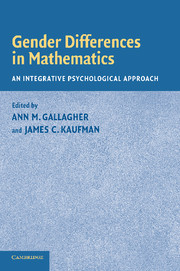Book contents
- Frontmatter
- Contents
- Preface
- Acknowledgments
- List of Contributors
- 1 Research on the Women and Mathematics Issue: A Personal Case History
- 2 The Perseverative Search for Sex Differences in Mathematics Ability
- 3 A Psychobiosocial Model: Why Females Are Sometimes Greater Than and Sometimes Less Than Males in Math Achievement
- 4 Gender Differences in Math: Cognitive Processes in an Expanded Framework
- 5 Cognitive Contributions to Sex Differences in Math Performance
- 6 Spatial Ability as a Mediator of Gender Differences on Mathematics Tests: A Biological–Environmental Framework
- 7 Examining Gender-Related Differential Item Functioning Using Insights from Psychometric and Multicontext Theory
- 8 The Gender-Gap Artifact: Women's Underperformance in Quantitative Domains Through the Lens of Stereotype Threat
- 9 “Math is hard!” (Barbie™, 1994): Responses of Threat vs. Challenge-Mediated Arousal to Stereotypes Alleging Intellectual Inferiority
- 10 The Role of Ethnicity on the Gender Gap in Mathematics
- 11 The Gender Gap in Mathematics: Merely a Step Function?
- 12 “I can, but I don't want to”: The Impact of Parents, Interests, and Activities on Gender Differences in Math
- 13 Gender Effects on Mathematics Achievement: Mediating Role of State and Trait Self-Regulation
- 14 Gender Differences in Mathematics Self-Efficacy Beliefs
- 15 Gender Differences in Mathematics: What We Know and What We Need to Know
- Author Index
- Subject Index
- References
6 - Spatial Ability as a Mediator of Gender Differences on Mathematics Tests: A Biological–Environmental Framework
Published online by Cambridge University Press: 05 June 2012
- Frontmatter
- Contents
- Preface
- Acknowledgments
- List of Contributors
- 1 Research on the Women and Mathematics Issue: A Personal Case History
- 2 The Perseverative Search for Sex Differences in Mathematics Ability
- 3 A Psychobiosocial Model: Why Females Are Sometimes Greater Than and Sometimes Less Than Males in Math Achievement
- 4 Gender Differences in Math: Cognitive Processes in an Expanded Framework
- 5 Cognitive Contributions to Sex Differences in Math Performance
- 6 Spatial Ability as a Mediator of Gender Differences on Mathematics Tests: A Biological–Environmental Framework
- 7 Examining Gender-Related Differential Item Functioning Using Insights from Psychometric and Multicontext Theory
- 8 The Gender-Gap Artifact: Women's Underperformance in Quantitative Domains Through the Lens of Stereotype Threat
- 9 “Math is hard!” (Barbie™, 1994): Responses of Threat vs. Challenge-Mediated Arousal to Stereotypes Alleging Intellectual Inferiority
- 10 The Role of Ethnicity on the Gender Gap in Mathematics
- 11 The Gender Gap in Mathematics: Merely a Step Function?
- 12 “I can, but I don't want to”: The Impact of Parents, Interests, and Activities on Gender Differences in Math
- 13 Gender Effects on Mathematics Achievement: Mediating Role of State and Trait Self-Regulation
- 14 Gender Differences in Mathematics Self-Efficacy Beliefs
- 15 Gender Differences in Mathematics: What We Know and What We Need to Know
- Author Index
- Subject Index
- References
Summary
It is well known that there is a gender difference on a number of standardized mathematics tests, with males outperforming females (Hyde, Fennema, & Lamon, 1990; Willingham & Cole, 1997). In addition, a relationship has been found between spatial abilities and mathematics test scores (Burnett, Lane, & Dratt, 1979; Casey, Nuttall, Pezaris, & Benbow, 1995; Casey, Nuttall, & Pezaris, 1997; Geary, Saults, Liu, & Hoard, 2000; Robinson, Abbott, Berninger, & Busse, 1996). This relationship may be key for understanding gender differences in mathematics because one of the best-known and largest gender differences is the male advantage on some types of spatial skills (Linn & Petersen, 1985). In fact, evidence has begun to accumulate that shows a connection between gender differences in mathematics achievement and gender differences in spatial skills (Casey et al., 1995; Casey et al., 1997; Casey, Nuttall, & Pezaris, 2001).
In this chapter, we review our research findings, which were designed to address a series of questions to better understand gender differences in math achievement. We propose that gender differences in spatial skills are the key to understanding gender differences in math achievement. After presenting findings on this connection, the conclusion of the chapter provides a biological/environmental framework to help understand how variations in spatial abilities might arise.
GENDER DIFFERENCES IN MATH ACHIEVEMENT
The observed gender differences in mathematics performance are not universal (Hedges & Nowell, 1995; Hyde et al., 1990).
- Type
- Chapter
- Information
- Gender Differences in MathematicsAn Integrative Psychological Approach, pp. 121 - 142Publisher: Cambridge University PressPrint publication year: 2004
References
- 5
- Cited by



